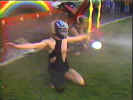PSim Home > York Corpus Christi Play [ Staging | Contexts | Origin | Glossary ]
Staging | Scholarly Debate [ Length | Rules ] | Analysis [ Stations | Plays | Observations ] Results | Conclusion
Before modern attempts to reconstruct large-scale productions of the York plays, scholars debated just how the surviving manuscript was performed in medieval times.
 The York Corpus Christi Cycle, a collection of brief
plays that together tell Biblical history from Creation
to Doomsday, was
the most complex of the medieval mystery cycles. The surviving manuscript
of 48 plays (with a combined length four times that of the longest Hamlet
text) and the civic and guild records of the town of York give us much
information on the nature of those productions, which took place annually
on the feast of Corpus Christi
from the late 14th century to the early 16th century. The scholarly debate
over how the plays were performed has settled down in favor of what had
been the traditional view -- that each short play, mounted on an individual
stage-wagon,
was pulled through the streets of York, stopping to perform for audiences
that had gathered at predetermined "stations" along the route.
The York Corpus Christi Cycle, a collection of brief
plays that together tell Biblical history from Creation
to Doomsday, was
the most complex of the medieval mystery cycles. The surviving manuscript
of 48 plays (with a combined length four times that of the longest Hamlet
text) and the civic and guild records of the town of York give us much
information on the nature of those productions, which took place annually
on the feast of Corpus Christi
from the late 14th century to the early 16th century. The scholarly debate
over how the plays were performed has settled down in favor of what had
been the traditional view -- that each short play, mounted on an individual
stage-wagon,
was pulled through the streets of York, stopping to perform for audiences
that had gathered at predetermined "stations" along the route.
But even within this generally-accepted framework, scholars manage to differ considerably in their interpretation of exactly what constitutes a performance. Chief points of contention include estimating the amount of time it would take for each of the 48 surviving plays to be performed and the organizational system for moving the wagons from station to station. Other details which have not previously figured strongly in time studies, and which consequently have not been fully examined, include the number of performance stations along the route and the number of plays which actually participate in any given year.
by Dennis
G. Jerz
June, 1997 -- first published in (Re)Soundings
16 Jul 1999 -- posted here
02 Jan 2001
-- last modified
PSim Home > York Corpus Christi Play [ Staging | Contexts | Origin | Glossary ]